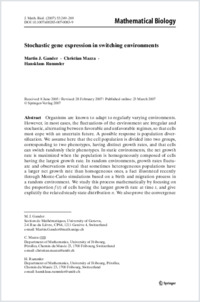Stochastic gene expression in switching environments
- Gander, Martin J. Section de Mathématiques, University of Geneva, Switzerland
- Mazza, Christian Department of Mathematics, University of Fribourg, Switzerland
- Rummler, Hansklaus Department of Mathematics, University of Fribourg, Switzerland
-
30.04.2007
Published in:
- Journal of Mathematical Biology. - 2007, vol. 55, no. 2, p. 249-269
English
Organisms are known to adapt to regularly varying environments. However, in most cases, the fluctuations of the environment are irregular and stochastic, alternating between favorable and unfavorable regimes, so that cells must cope with an uncertain future. A possible response is population diversification. We assume here that the cell population is divided into two groups, corresponding to two phenotypes, having distinct growth rates, and that cells can switch randomly their phenotypes. In static environments, the net growth rate is maximized when the population is homogeneously composed of cells having the largest growth rate. In random environments, growth rates fluctuate and observations reveal that sometimes heterogeneous populations have a larger net growth rate than homogeneous ones, a fact illustrated recently through Monte-Carlo simulations based on a birth and migration process in a random environment. We study this process mathematically by focusing on the proportion f(t) of cells having the largest growth rate at time t, and give explicitly the related steady state distribution π. We also prove the convergence of empirical averages along trajectories to the first moment Επ(f), and provide efficient numerical methods for computing Επ(f)
- Faculty
- Faculté des sciences et de médecine
- Department
- Département de Mathématiques
- Language
-
- English
- Classification
- Mathematics
- License
-
License undefined
- Identifiers
-
- RERO DOC 8450
- DOI 10.1007/s00285-007-0083-9
- Persistent URL
- https://folia.unifr.ch/unifr/documents/300503
Statistics
Document views: 128
File downloads:
- Fichier principal: 213
